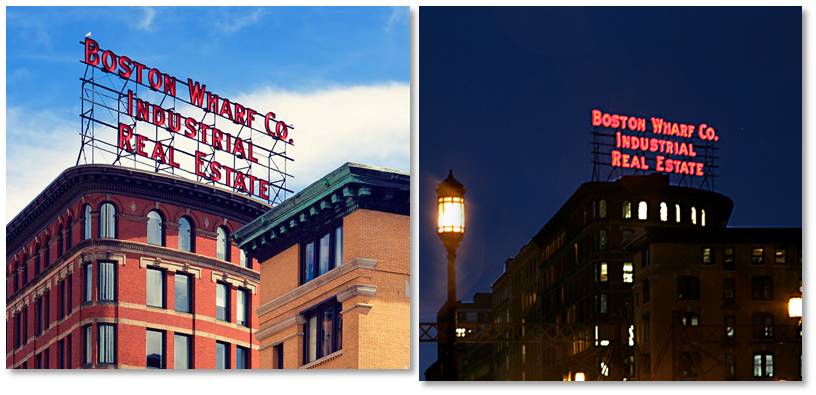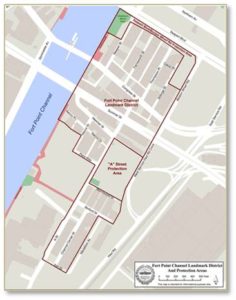Bostonians feel fiercely protective of the iconic Citgo sign in Kenmore Square and folks who commute north on I-93 know the old Scrafft’s sign that has bern renovated and updated. The city displays one other large illuminated sign, however, that doesn’t get as much attention or respect. (Boston, not Cambridge. Sorry, Shell sign.)
The Boston Wharf Company sign atop 263 Congress Street, at the corner of Sleeper Street, lacks Citgo’s dynamic colors and movement and Schrafft’s curvy letters. It states what it is and what it offers in simple block letters. The sign’s message remains as simple and matter of fact as one would expect from a company that built an industrial area out of mud flats:
Boston Wharf Co.
Industrial Real Estate
The Boston Wharf Company
That’s it. The sign is so plain that it’s easy to walk past without paying it much attention. But those red block letters have been lighting up the Fort Point Channel district for decades. Still, why is it there?
The Boston Wharf Company, incorporated in 1836, planned to build commercial wharves in the South Boston Flats, an area described by author and historian Nancy Seasholes as:
“ . . . a vast expanse of mud covered with luxuriant sea grass interlaced with navigable muddy brooks called guzzles, which extended almost a mile north of First Street.”
They constructed a seawall around the area and filled it with dirt from Nook Hill in South Boston. For the next 46 years, the company created land with gravel as well as clay dredged from the harbor and the Fort Point Channel and turned the Flats into 55 acres of commercial real estate.
A Planned Neighborhood
That meant they built one of the few planned neighborhoods in the city. The BWC sectioned the land into lots and laid out streets. They named the streets after the company’s officers and prominent tenants in their buildings:
- Binford Street
- Farnsworth Street
- Melcher Street
- Midway Street
- Pittsburgh Street (Renamed Thomson Place when Thomson Reuters bought the building.).
- Sleeper Street
- Stillings Street
- Necco Court
The BWC created commercial structures buildings that were designed for the manufacture and storage of a wide variety of goods that changed over time. Sugar and molasses took priority at first but the tenants had gone into the wool trade by the end of the 19th century.
A Planned Area of Uniform Design
The Boston Wharf Company’s staff architects designed ranks of warehouses between the 1880s and the 1920s in uniform heights and sizes. The buildings, which are constructed of masonry, have “classically inspired details concentrated at the entrances and cornices,” and flat roofs. A circular copper medallion stamps each of the buildings with a BWC logo in relief.
The Boston Landmarks Commission, describes the BWC’s buildings as representing:
“an unusually coherent and well-preserved collection of late 19th and early 20th century lofts that reflect a critical period of social, economic, and physical development in the City and the region.”
The Fort Point Channel District Emerges
When the wool trade declined, tenants commercial moved out and the buildings were abandoned for a while. Eventually, artists moved in to the warehouses that are well lit by large windows and many lived there illegally until they could convert the lofts to residences. As the Fort Point Channel neighborhood gentrifies, the BWC’s buildings are being converted into restaurants, hotels, sandwich shops, bars, galleries, and other less industrial businesses.
The Fort Point Channel Historic District was added to the National Register of Historic Places in 2004. The Boston Landmarks Commission official approved the area as an historic district in 2009.
To check out the interiors, just buy dinner or a drink as the price of admission.You can also check out the Marriott Residence Hotel’s white brick atrium by walking into the lobby. For an even better way to see these old buildings on the inside, attend a Fort Point Channel Open Studios event sponsored every year by the Fort Point Arts Community, Inc.
The Big Red Sign Abides
I haven’t been able to pin down exactly when the Boston Wharf Company sign was erected—although 263 Congress Street was completed in 1905. But I find the sign’s red glow particularly warm and friendly against the night sky.
Boston never had many large neon signs. Those that have disappeared, like the old Domino Sugars sign that was also on the Fort Point Channel, didn’t go into a neon boneyard. We are just now beginning to appreciate them as an art form instead of a advertising blight on the cityscape. So I’m glad the Boston Wharf Company sign has weathered the times and continues to brighten Boston’s skyline.




I frequently do business at the South Postal Annex next to South Station and
have been enjoying that sign for decades. But parts of it frequently succumb to weather! Tonight April 18, 2022 it was BOSTON WHARF COMPANY INDUSTRIAL REAL ATE! Particularly choice awhile back was a canine period when the firm was the BOSTON ARF COMPANY.
You need to participate in a contest for probably the greatest blogs on the web. I will recommend this website!
When I lived in England (corporate relocation with DEC) I traveled between Boston and London every other month. Seeing the Citgo sign – especially at night – always felt like coming home!
How interesting! I miss the Spaghetti Factory on what used to be Pittsburgh Street I think.